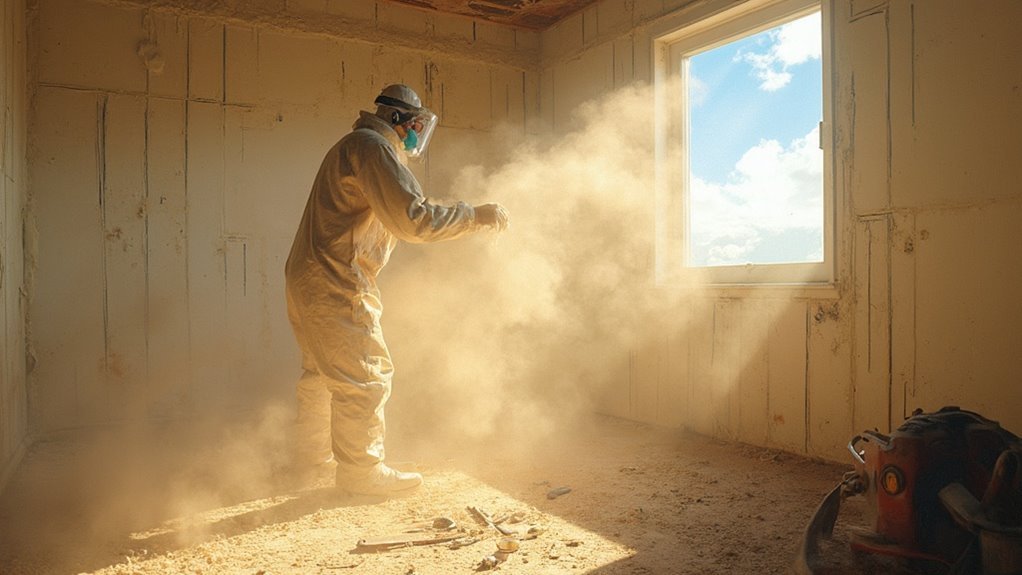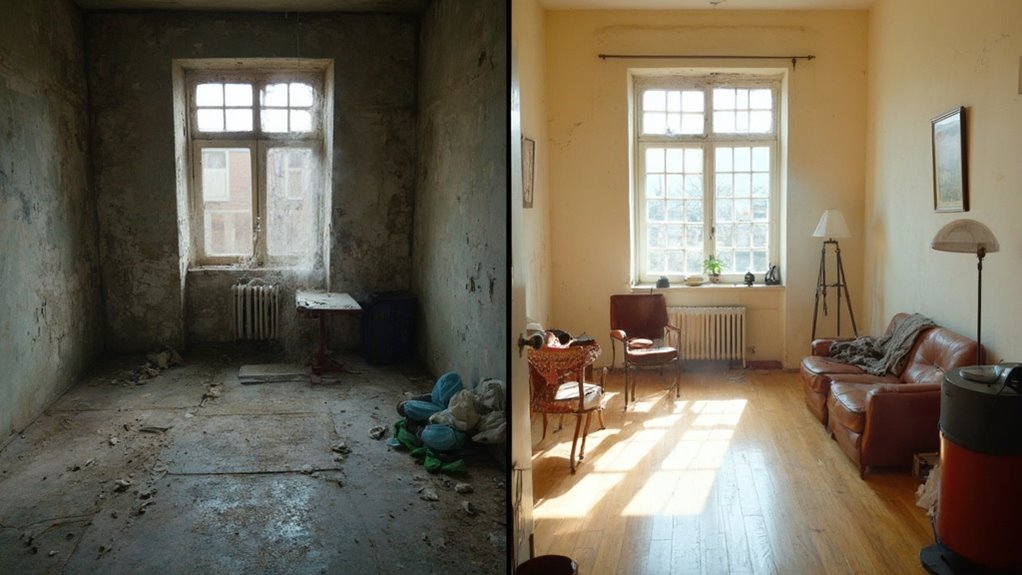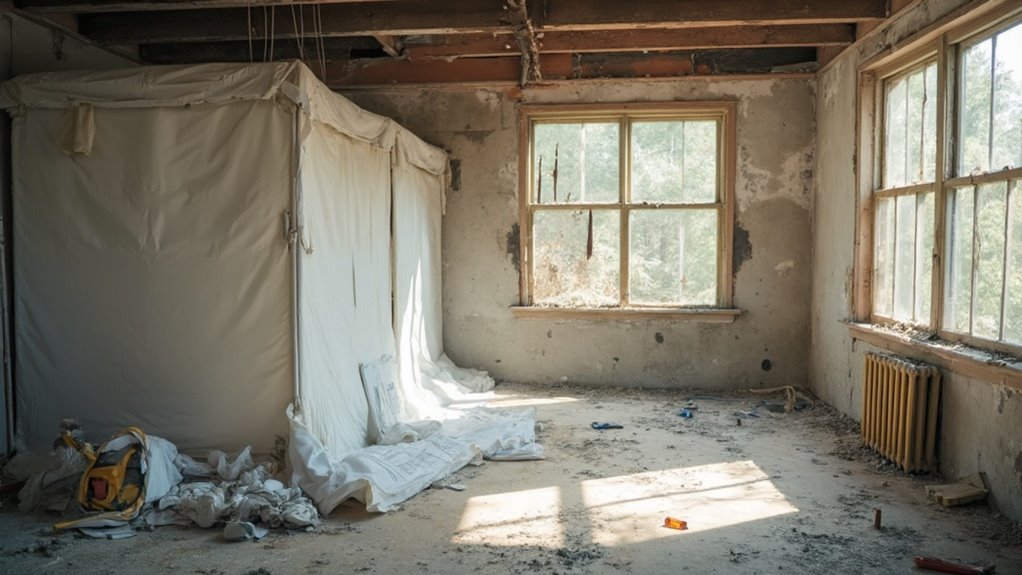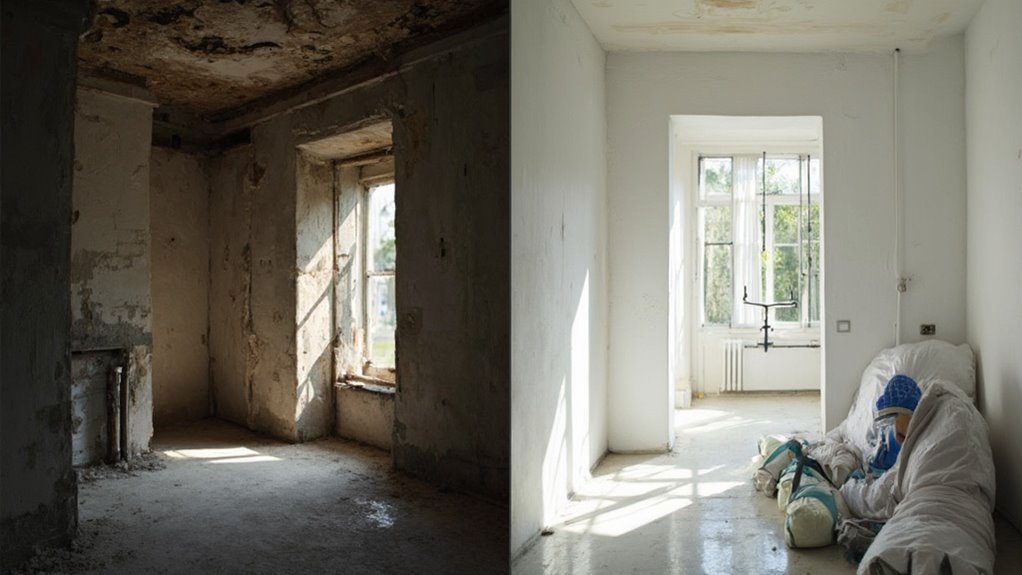Asbestos abatement is vital for transforming your home from a hazardous space to a safe haven. You'll start with a thorough risk assessment to identify asbestos presence and create an action plan that complies with EPA standards. Safety measures involve sealing the work area and using protective gear for workers. Employing proper abatement techniques guarantees meticulous removal, while post-abatement inspections and air quality tests confirm your home's safety. This extensive process not only eliminates health risks associated with asbestos but likewise protects your family's well-being. Continue exploring further details to understand the complete abatement journey and its benefits.
Understanding Asbestos Hazard

When it comes to understanding the asbestos hazard, it's vital to recognize that this natural mineral fiber poses considerable health risks if inhaled. There are several asbestos types, including chrysotile, amosite, and crocidolite, each linked to severe health effects. Exposure to these fibers has been classified as a known human carcinogen by authoritative health organizations, including the U.S. EPA and the IARC. Asbestos exposure can lead to serious diseases, with most mesotheliomas, a rare but aggressive cancer, directly attributed to asbestos exposure. Moreover, long-term exposure may cause asbestosis, a chronic lung disease characterized by lung scarring and inflammation, resulting in shortness of breath and permanent damage. Nonmalignant lung conditions, like pleural plaques and thickening, can likewise arise from asbestos exposure. Additionally, specific groups at higher risk include workers in certain industries where asbestos is prevalent.
Furthermore, the risks multiply for smokers, as the combination of asbestos and tobacco greatly increases the likelihood of lung cancer. Understanding these hazards highlights the importance of recognizing asbestos in your environment and addressing it promptly, as the latency period for related diseases can span decades, emphasizing the need for vigilance and awareness.
Preparing for Abatement
Before starting asbestos abatement, you must develop a thorough action plan that outlines the methods for removal and safety protocols. Make certain you identify the necessary safety equipment, including personal protective gear, to protect workers during the process. This preparation is vital for compliance and minimizing risk throughout the abatement project. Additionally, ensuring adherence to EPA and OSHA standards is crucial for safeguarding both workers and residents.
Action Plan Development
Typically, developing an effective action plan for asbestos abatement requires meticulous attention to detail and a structured approach. Start by conducting a thorough risk assessment to confirm the presence of asbestos and determine the most suitable removal strategy. This will help you outline the scope of work clearly.
Next, create a detailed abatement plan that includes timeline management for the entire project. Your timeline should encompass preparation, removal, and cleanup phases, guaranteeing that each step is clearly defined. Don't forget to notify regulatory agencies and obtain the necessary permits, as compliance with local and federal regulations is vital.
Before abatement begins, seal off the work area with plastic sheeting and employ negative air pressure machines to contain any potential fiber spread. You'll likewise need to clear the area of personal belongings and turn off HVAC systems to prevent contamination.
Finally, confirm that your plan includes the construction of decontamination units for worker safety. By following these detailed steps, you can effectively prepare for asbestos abatement, transforming your home from a hazard into a safe haven.
Safety Equipment Requirements
An effective asbestos abatement action plan hinges on the proper use of safety equipment. Your first step is PPE selection, which includes respiratory equipment like half or full facepiece respirators fitted with high-efficiency filters. Protective clothing, made from synthetic fabrics, should block tiny asbestos fibers, while gumboots and shoe coverings guarantee easy cleaning. Use single-use gloves to prevent fibers from becoming trapped under your nails, and safety goggles will protect your eyes from dust.
When choosing safety clothing, verify it fits tightly at the cuffs and ankles to maintain a proper seal. The material should be smooth, allowing for high abrasion resistance and easy movement. Always check your equipment for maintenance needs before beginning work.
Additional measures include sealing work areas with plastic sheeting, turning off HVAC systems, and clearing personal items to prevent contamination. After the abatement, thoroughly decontaminate the area and dispose of all PPE as asbestos waste. Finally, conduct air quality tests to confirm the environment is safe for re-entry. Following these safety equipment requirements is vital for effective and safe asbestos abatement.
Essential Safety Measures

Effective asbestos abatement requires strict adherence to important safety measures at every stage of the process. By implementing these fundamental safety protocols, you can guarantee not only the safety of the workers but also the protection of your home and its occupants. Here are key steps to take into account:
- Notification and Permitting: Inform relevant authorities and secure necessary permits before starting any work.
- Area Isolation: Seal off the work area with plastic sheeting to prevent asbestos fibers from spreading.
- Worker Training: Confirm all workers receive proper training and certification in handling asbestos safely.
- Protective Equipment: Equip workers with appropriate protective gear, including respirators and disposable coveralls.
These measures are critical for minimizing risk during abatement. Conducting a thorough risk assessment helps determine the safest approach, while using wet methods and HEPA vacuums during the process greatly reduces fiber release. Post-abatement, clearance testing and area cleaning guarantee the environment is safe for re-entry. By prioritizing these fundamental safety measures, you're not just following regulations; you're actively safeguarding your health and peace of mind.
Types of Abatement Techniques
When addressing asbestos abatement, you'll encounter several techniques tailored to different situations. Class I techniques include removal and encapsulation methods, each serving unique purposes based on the condition and location of asbestos-containing materials. Furthermore, understanding waste disposal practices is essential for ensuring compliance with regulations and maintaining safety throughout the process.
Class I Techniques
How can you assure the safe removal of asbestos-containing materials? By utilizing Class I techniques, which are specifically designed for the removal of thermal system insulation (TSI) and surfacing asbestos-containing materials (ACM). These methods guarantee that you minimize risks and comply with all necessary regulations.
Here are four key elements to contemplate:
- Isolation: Protecting the work area with critical barriers to prevent asbestos exposure.
- Wet Methods: Using water to suppress dust during the removal process, reducing airborne fibers.
- Personal Protective Equipment (PPE): Confirming workers wear appropriate gear, including respirators, to safeguard against inhalation.
- Proper Waste Disposal: Sealing asbestos waste in designated bags for disposal at licensed landfills.
Class I abatement methods are thorough and include meticulous preparation, removal, and post-abatement cleaning. Workers undergo rigorous training to follow safety protocols and decontamination procedures. By hiring certified professionals who specialize in these abatement methods, you're not just removing hazardous materials; you're transforming your home into a safe haven free of asbestos risk.
Encapsulation Methods
Class I techniques focus on the removal of asbestos to eliminate risks, but encapsulation methods offer an alternative approach when complete removal isn't feasible or necessary. Encapsulation techniques involve sealing or enclosing asbestos-containing materials (ACMs) to prevent fiber release. The process begins with a thorough assessment to identify the type, condition, and location of ACMs, followed by evaluating the risks associated with encapsulation.
Common methods include sealing ACMs with binding agents, covering them with materials like sheet metal cladding, and applying protective seals to any damaged areas. After encapsulation, it's essential to place warning labels to prevent accidental disturbance.
The encapsulation benefits are significant. It minimizes risk by preventing fibers from becoming airborne, making it a quick and cost-effective option compared to removal. Furthermore, it requires less renovation while maintaining the desirable characteristics of ACMs, such as fire resistance and insulation properties.
Waste Disposal Practices
As you engage in asbestos abatement, understanding waste disposal practices is crucial to ensuring safety and compliance. Proper waste management not only protects your health but likewise adheres to strict disposal regulations designed to mitigate environmental risks. Here are key practices you should follow:
- Preparation: Wet asbestos materials to prevent fiber release.
- Containerization: Use leak-proof bags or containers, ensuring they're at least 6 mil thick.
- Labeling: Clearly mark each container with warnings about asbestos hazards.
- Disposal: Always seal and bag waste, disposing of it at licensed landfills.
Step-by-Step Abatement Process

Conducting an effective asbestos abatement process involves a series of meticulously planned steps to guarantee safety and compliance. First, a trained asbestos inspector assesses your property to identify potential asbestos sources. Samples are collected and sent for laboratory analysis, leading to a tailored abatement plan that outlines the safe removal process.
Preparation is essential. The work area is isolated using plastic sheeting and negative air pressure units to prevent fiber spread. Workers are equipped with protective gear to ascertain their safety. During the abatement process, the area is sealed off, and HEPA filters create negative pressure, trapping airborne fibers.
Asbestos-containing materials are either removed or encapsulated, depending on their condition. Wetting the materials minimizes fiber release during removal. Specialized tools help reduce dust, securing a safer environment. After removal, thorough cleaning with HEPA vacuums and wet methods is performed.
The abatement timeline concludes with air quality testing to confirm safe asbestos levels and proper disposal of waste in licensed landfills. A certified inspector verifies the area's cleanliness, providing you with a certificate of completion to demonstrate compliance with all regulations.
Importance of Post-Abatement Actions
The successful completion of the asbestos abatement process sets the stage for the importance of post-abatement actions. These actions are vital to guarantee the safety and health of your environment. Neglecting them can lead to serious consequences, so take them seriously.
Here are four fundamental post-abatement actions you shouldn't overlook:
- Conduct post abatement inspections: Perform thorough visual inspections to confirm all asbestos has been addressed.
- Implement air quality monitoring: Use air sampling techniques to verify that asbestos fiber levels are safe for occupancy.
- Schedule clearance testing: Ascertain the abated area passes clearance testing before re-entering.
- Engage certified professionals: Always rely on licensed contractors and certified inspectors for testing and inspections.
Ensuring Regulatory Compliance

Guaranteeing regulatory compliance in asbestos abatement is vital for safeguarding both public health and the environment. You need to stay updated on regulatory updates, which can change frequently, presenting compliance challenges. Understanding the different layers of regulations—from federal standards like the NESHAP to specific state or local rules—is fundamental for a successful abatement process.
| Key Compliance Steps | Impact of Non-Compliance |
|---|---|
| Conduct a thorough asbestos survey | Health risks to occupants |
| Develop a detailed abatement plan | Fines and legal repercussions |
| Notify regulatory agencies | Project delays and increased costs |
| Confirm certified professionals are involved | Damage to reputation and trust |
Frequently Asked Questions
How Long Does the Entire Abatement Process Typically Take?
The abatement timeline varies based on project duration, ranging from one day for small projects to several weeks for large ones. Consider factors like asbestos amount, accessibility, and complexity to estimate your specific timeline effectively.
What Costs Are Associated With Asbestos Abatement Services?
Asbestos abatement costs vary based on testing, removal techniques, and the project's scale. You'll face expenses for inspections, labor, and disposal, with average removal costs ranging from $1,192 to $3,255, depending on specific circumstances.
Can I Stay in My Home During the Abatement?
During asbestos abatement, safety precautions necessitate temporary relocation. You can't stay in your home while the work occurs, as exposure risks increase. Prioritize your health by following professional guidance for a secure, safe environment.
What Happens to My Belongings During the Abatement?
During abatement, your belongings require protection. You should remove and clean items, store them safely outside the work area, and guarantee non-removable items are covered with polyethylene sheeting to minimize contamination risks.
Will My Home Insurance Cover Asbestos Abatement Costs?
Your home insurance typically doesn't cover asbestos abatement unless it's part of a covered peril outlined in your insurance policies. Review your policy details to understand specific asbestos coverage and any potential exclusions.
